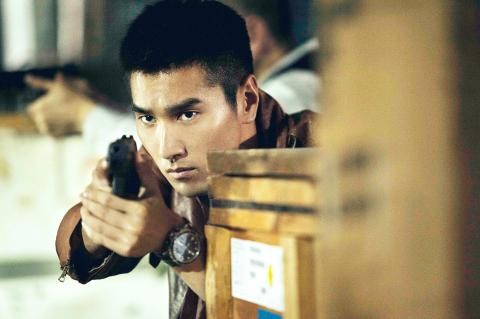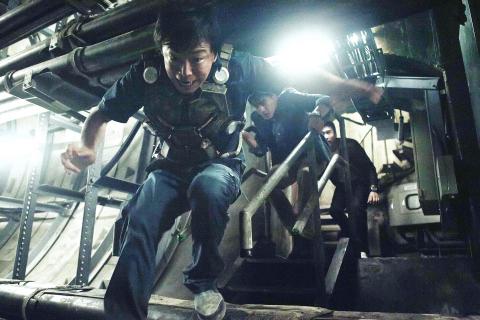For anyone accustomed to Hollywood animation, The Frogville will seem amateurish. But as the first 3D animated feature made in Taiwan, the film’s shortcomings partly reflect the state of the country’s animation industry.
Once a large cartoon production exporter, Taiwan’s animation industry was founded on original equipment manufacturer (OEM) orders for big US studios. It gradually lost market share to South Korea, China, the Philippines and other countries. Over the decades, Taiwan’s animation market has never grown mature enough to support the production of 2D features, let alone high-quality 3D animation that requires costly high-tech support.
It is against this backdrop that director Yang Jen-hsien (楊仁賢), a veteran animator who used to work at Wang Film Production (宏廣動畫), one of Taiwan’s biggest animation studios, dedicated himself to the six-year project, working with a crew of less than 10 people and a tiny budget of NT$30 million.

Photo Courtesy of Prajna Works
The storytelling and visual design are somewhat crude, as is the animation quality.
Despite limited resources, however, Yang and his team manage to pull together a structurally tidy and scientifically accurate work aimed at families.
The film follows a group of Heymons’ narrow-mouthed toads as they flee their habitat, which has become polluted by humans and invaded by a gang of American bullfrogs, a foreign species-turned-menacing intruder who feed on smaller creatures, including other frogs.

Photo Courtesy of Prajna Works
Closely connected to what happens to Taiwan’s environment, the film also touches on the government’s controversial land expropriations, showing how human characters, like their amphibious counterparts, are forced to leave their homes.
BLACK AND WHITE
Following director Tsai Yueh-hsun’s (蔡岳勳) 2012 action blockbuster Black and White: The Dawn of Assault (痞子英雄首部曲:全面開戰), the latest installment of the police action series is definitely much grander in scale, with participation of filmmaking professionals and special visual effects and 3D production companies from Taiwan, Hong Kong, China, Japan, Thailand, France, Australia and Hollywood.

Photo Courtesy of Flash Forward Entertainment
The movie opens with a dramatic car chase and several explosions that sabotage all of the roadways leading in and out of the city.
All evidence points to the leader of a supposedly defunct special army unit as the mastermind behind the destruction, suggesting a much more nefarious operation is underway.
The city’s inhabitants must depend on police officers Wu Ying-xion and Chen Zhen, played by China’s Kenny Lin (林更新), to save the city from mass destruction.
Collapsed buildings, airplanes and trains crashing on to city streets, a rocket attack and a biological weapons keep the movie going at a frenetic pace. The demented mastermind behind these events believes that only total destruction of the earth will bring with it rebirth.
The apocalyptic mood, however, is overshadowed by a thinly developed story and one-dimensional characters, an unfortunate holdover from the first movie.
To be fair, we don’t expect Tsai’s demonic creation to be anything like Heath Ledger’s Joker in The Dark Knight, but the lack of intensity and gravitas renders the movie little more like an expensive video game for men.
Film notes
Black and White: The Dawn of Justice (痞子英雄:黎明再起)
Directed by: Tsai Yueh-hsun (蔡岳勳)
Starring: Mark Chao (趙又廷) as Wu Ying-xiong, Kenny Lin (林更新) as Chen Zhen, Huang Bo (黃渤) as Xu Dafu, Janine Chang (張鈞甯) as Lan Xi-ying, Tsai Yueh-hsun as Lan Xi-en
Language: In Mandarin with Chinese and English
Running time: 127 Minutes
Taiwan release: In theaters
The Frogville (桃蛙源記)
Directed by: Yang Jen-hsien (楊仁賢)
Starring: Kuo Shu-yao (郭書瑤) as Heymon, Lin Hsieh-chung (林協忠) as Bull Boss, Lin Kai-ling (林凱羚) as Xiao Ge, Tseng Yun-fan (曾允凡) as Mei
Language: in Mandarin with Chinese and English subtitles
Running time: 85 Minutes
Taiwan release: Today

The canonical shot of an East Asian city is a night skyline studded with towering apartment and office buildings, bright with neon and plastic signage, a landscape of energy and modernity. Another classic image is the same city seen from above, in which identical apartment towers march across the city, spilling out over nearby geography, like stylized soldiers colonizing new territory in a board game. Densely populated dynamic conurbations of money, technological innovation and convenience, it is hard to see the cities of East Asia as what they truly are: necropolises. Why is this? The East Asian development model, with

June 16 to June 22 The following flyer appeared on the streets of Hsinchu on June 12, 1895: “Taipei has already fallen to the Japanese barbarians, who have brought great misery to our land and people. We heard that the Japanese occupiers will tax our gardens, our houses, our bodies, and even our chickens, dogs, cows and pigs. They wear their hair wild, carve their teeth, tattoo their foreheads, wear strange clothes and speak a strange language. How can we be ruled by such people?” Posted by civilian militia leader Wu Tang-hsing (吳湯興), it was a call to arms to retake

This is a deeply unsettling period in Taiwan. Uncertainties are everywhere while everyone waits for a small army of other shoes to drop on nearly every front. During challenging times, interesting political changes can happen, yet all three major political parties are beset with scandals, strife and self-inflicted wounds. As the ruling party, the Democratic Progressive Party (DPP) is held accountable for not only the challenges to the party, but also the nation. Taiwan is geopolitically and economically under threat. Domestically, the administration is under siege by the opposition-controlled legislature and growing discontent with what opponents characterize as arrogant, autocratic

When Lisa, 20, laces into her ultra-high heels for her shift at a strip club in Ukraine’s Kharkiv, she knows that aside from dancing, she will have to comfort traumatized soldiers. Since Russia’s 2022 invasion, exhausted troops are the main clientele of the Flash Dancers club in the center of the northeastern city, just 20 kilometers from Russian forces. For some customers, it provides an “escape” from the war, said Valerya Zavatska — a 25-year-old law graduate who runs the club with her mother, an ex-dancer. But many are not there just for the show. They “want to talk about what hurts,” she